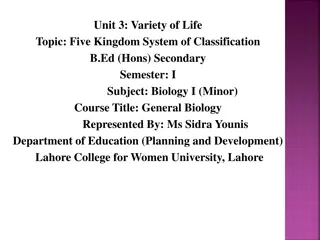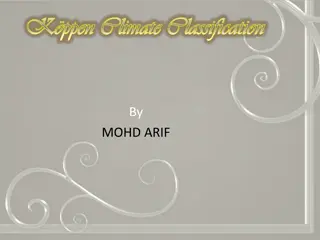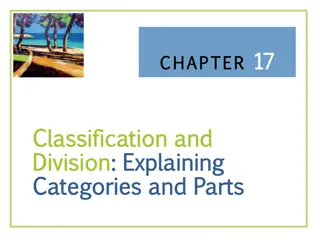Understanding Mammalia Classification and Characteristics
Mammalia, a class of animals, exhibit distinct characteristics like hair presence, mammary glands for young ones, and warm-bloodedness. They are classified into subclasses like Prototheria (egg-laying), Metatheria (marsupials), and Eutheria (placental mammals). Monotremes belong to Prototheria and include unique animals like the platypus. Marsupials have marsupium pouches and double reproductive systems. Learning about the orders and features within Mammalia helps understand the diversity of mammals.
Download Presentation

Please find below an Image/Link to download the presentation.
The content on the website is provided AS IS for your information and personal use only. It may not be sold, licensed, or shared on other websites without obtaining consent from the author. Download presentation by click this link. If you encounter any issues during the download, it is possible that the publisher has removed the file from their server.
E N D
Presentation Transcript
MAMMALIA CLASSIFICATION
General characters Mammology- study of mammals Presence of hair Female have mammary glands for for suckling the young Skin glands such as sebaceous (oil) gland and sweat gland present Muscular diaphragm present between thoracic and abdominal cavity Dicondylic skull Cervical vertebrae 7 in number Heterodont and thecodont teeth Warm blooded (homeothermic) Small and non-nucleated R.B.C. Metanephric kideys Ureotelic excretion Brain highly evolved and convulated 4 optic lobes forms corpora quadrigemina Corpus callosum present connecting both cerebral hemispheres except monotremes and marsupials 12 pairs of cranial nerves External ear opening with pinna except monotremes and middle ear with malleus, incus and stapes Viviparous except egg laying monotremes
CLASS- MAMMALIA SUBCLASS- PROTOTHERIA SUBCLASS- METATHERIA SUBCLASS- EUTHERIA ORDER- MONOTREMATA ORDER- MARSUPIALIA
Prototheria protos (Gr) first; ther (Gr) a wild animal. proton, theriomorphic (having the form of an animal. Order Monotremata: monas (Gr) single; trema (Gr) a hole. monotone, trematode (a parasitic flatworm). Refers to the cloaca (cloaca) Family Ornithorhynchidae: ornithos (Gr) a bird; rhunkhos (Gr) a bill or snout. Family Tachyglossidae: takhus (Gr) fast; glossa (gr) tongue.
ORDER- MONOTREMATA Cloaca present Teeth in young beak in adult Oviparous with reptile like Characters Mammals that lay eggs with leathery shells and nourish the young ones with milk from primitive(open) mammary glands. Found only in Australian region Mammary glands without teats No corpus callosum Pinna absent No placenta Example- Ornithorhynchus (Platypus/duckbill) and Echidna (spiny anteater)
Subclass Metatheria Meta (Gr) can mean among or later, you pick; ther (Gr) a wild animal. metatarsus (between the ankle and the phalanges, metatheria, between the proto and the eu), theriomorphic (having the form of an animal,
ORDER- MARSUPIALIA Brood pouch or marsupium present in female Double vagina and uterus Corpus callosum absent Pinna present Example- Macropus (kangaroo)
SUBCLASS- EUTHERIA ORDER- INSECTIVOTRA eg Shrew ORDER- CHIROPTERA eg Bats ORDER- DERMOPTERA eg Flying squirrel ORDER- EDENTATA eg ant eaters ORDER- PHOLIDOTA eg pangolin/scaly anteater) ORDER- TUBULIDENTATA ORDER- RODENTIA ORDER- LAGOMORPHA ORDER- CETACEA ORDER- SIRENIA ORDER- CARNIVORA ORDER- HYRACOIDEA ORDER- PROBOSCIDEA ORDER- PERRISODACTYLA ORDER- ARTIODACTYLA ORDER- PRIMATES
ORDER- INSECTIVORA Small primitive mammals Long pointed snout Plantigrade feet with claws Nocturnal Dental formula= 2 x 3143/3143 Example- Sorex (shrew)
ORDER- CHIROPTERA Chiroptera is the name of the order of the only mammal capable of true flight, the bat. The name is influenced by the hand-like wings of bats, which are formed from four elongated "fingers" covered by a cutaneous membrane. It is based on the Greek words for "hand," "cheir," and "wing," "pteron." Flying mammals (bats) Limbs are with patagium(folds of skin) Sternum with keel for attachment of flight muscles Large pinnae Knee are directed backward During daytime they found suspended by their feet Nocturnal Capable of echolocationwhich helps them to locate object during flight Example- Pteropus (flying fox)
ORDER- DERMOPTERA Greek derma skin + pteron wing Lateral furry skin form patagium Gliding mammal called flying lemur Nocturnal and hang like bats Example- Cynocephalus (flying squirrel)
ORDER- EDENTATA order of mammals having few or no teeth Anteaters, armadillos and sloths Teeth absent in anteaters In armadillos and sloths incisors and canines are absent and molars present without enamal Toes with long claws Example- Myrmecophaga (giant anteater), Dasypus (armadillo) and Bradypus(3-toed sloth)
ORDER- PHOLIDATA an order of toothless scaly eutherian mammals comprising the pangolins that in many respects resemble true edentates and were formerly included in Edentata Body covered with large horny scales No teeth Tongue long and protrusible for capturing insects Example- Manis (pangolin/scaly anteater) from Greek pholid tos covered with scales, from pholid-, pholis
ORDER- TUBULIDENTATA Tongue slender and protrusible Teeth lack enamal Ears are long, erect and pointed Exampe- Orycteropus (aardvark/cape anteater) tubulidentatus having tubelike teeth, from tubuli- + -dentatus - dentate
ORDER- RODENTIA Largest order Gnawing mammals Each jaw with one pair of incisors Canines absent Gap between incisors and molars is called diastema Plantigrades Example- Rattus (rat) Rodentia, which are characterized by a single pair of continuously growing incisors in each of the upper and lower jaws.
ORDER- LAGOMORPHA an order of gnawing herbivorous mammals having two pairs of incisors in the upper jaw one behind the other, usually soft fur, and short or rudimentary tail, made up of two families (Leporidae and Ochotonidae) comprising the rabbits, hares, and pikas, and was formerly considered a suborder of the order Rodentia Canines absent Diatema present 2 pairs of incisor in upper jaw Example- Oryctolagus (rabbit)
ORDER- CETACEA Large marine fish like mammals Neck absent Hair present only in embryo Forelimbs are modifiied into flippers Tail divided into horizontal flukes Hindlimbs absent No external ears Blubber (fat) presentbeneath skin Example- Delphinus (dolphin) and Balaenoptera (blue whale)
ORDER- SIRENIA Herbivores aquatic mammals Neck absent Pinna absent Paddle like forelimbs Hindlimbs absent Horizontal flattened tail Hairs few Clavicles absent Phylogenetically related to ungulates Example- Halicore (dugong)
ORDER- CARNIVORA Predatory flesh eating mammals Claws well developed Canines large Mammae are abdominal Divided in two suborder Suborder- Fissipedia (terrestrial forms); Example-Panthera tigris (tiger) Suborder- Pinnipedia (marine forms) Example- Phoca (seal)
ORDER- HYRACOIDEA Snout,ear and legs short Forelimbs with 4 fingers Hindlimbs with 3 toes No canines Lower incisors are comb like Example- Hyrax (procavia)
ORDER- PERRISODACTYLA Odd toed (1 to 3) hoofed animals (ungulates) Unguligrades Herbivores Horns absent Stomach is simple Example- Equus (horse)
ORDER- ARTIODACTYLA Even toed (2 to 4) hoofed animals (ungulates) Somach complex (4 chambered) Ruminants except pigs Horns or antlers may present herbivores Example- Bubalus (water buffalo)
ORDER- PROBOSCIDEA Largest living land animals Pinna large Skin thick and hairless Nose and upper lip modified as an elongated flexible trunk Two upper incisors elongated as ivory tusks Legs pillar like not bend at knees Example- Elephas maximus (indian elephant)
ORDER- PRIMATES Nails present High intelligence quotient Eyes turned forward for binocular vision First finger opposable forms thumb Primarily arboreal Includes monkeys, apes and humans Example- Homo sapiens























